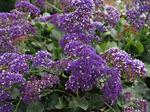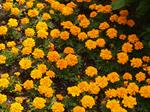 LANDSCAPING ANNUALS ONLINE COURSE
LANDSCAPING ANNUALS ONLINE COURSE
Become an expert on Herbaceous Annual Flowering Plants
Learn to identify, cultivate and propagate annuals, for bedding displays, potted colour or cut flowers
This course reveals the secrets of how to identify annual species, what to grow and when to grow each variety. It covers soil improvement, pest control, irrigation, propagation, greenhouse growing, hydroponics and much more. It is equally as useful to the home gardener and to the professional gardener as to those intending to grow annuals commercially.
Lesson Structure
There are 8 lessons in this course:
-
Introduction
-
Review of the system of plant identification, physiology, information sources
-
Culture
-
Planting, staking, mulching, watering, feeding, pruning, etc
-
Propagation
-
Methods of propagating annuals.
-
Propagation of selected varieties of annuals.
-
Growing Annuals in Hydroponics.
-
Pest & Disease
-
Irrigation
-
Greenhouse Management.
-
Harvest, Post Harvest & Quality.
Aims
-
Discuss the classification of annual flowering plants through the plant naming system.
-
Discuss culture requirements of annuals.
-
Propagate annuals.
-
Explain methods of hydroponic culture in relation to annuals
-
Identify pest and diseases of annuals
-
Describe various types of irrigation systems and the water requirements of annuals.
-
Describe various greenhouses and related equipment available.
-
Determine procedures for the handling of annuals during and after harvest.
-
Design annual flower beds.

How to Get the Most from Annuals
If you understand the plant life cycle and growth needs, this will help you to make the best display from annuals. This is very true for annuals grown for their flower show as the growth of these plants is generally very fast. Therefore, conditions must be right from the start since the growth period is so short.
Most plants that germinate from a seed need to grow and establish a certain amount of foliage before any flowers will start to form. If the initial growth is slow, it will be longer before the plant begins to flower. Once the plant is old enough and strong enough, the plant tissues mature and become capable of supporting flowers. After that point, the plant only needs the right set of stimuli to cause flowers to form. Different plant varieties have different sets of requirements, for example:
- The air temperature around the plant or a warmer root zone temperature.

- An increase or decrease in light levels and day length.
- A shortage of moisture, or extra moisture.
- A response to lack of nutrients, or excess nutrients of one sort or the other.
All these factors can encourage flower buds to form and blossom.
Timing is critical if you want annuals to flower well and for a long time!
If you read the seed packet, and plant the appropriate variety for your locality, right in the middle of the recommended planting time, you should produce a crop of flowers quickly and easily.
Timing
The timing of annual seed sowing is very important. Some annual seeds need cooler temperatures and may need to be covered and kept in the dark to germinate whereas other seeds need to be exposed to light and sown only on the surface of soil mixes. Some annuals prefer heat to germinate and grow, other varieties like it cool to grow. Some need heat to start

them off but then they want to continue to grow over the cooler months. Most of this relates to the timing in a seasonal year a particular variety likes to grow and flower.
If you do not sow seeds at the correct time, the plants will wither and die, simply not flower, or run to seed. For example, Primulas (Primrose) sown in spring and planted out into the garden as seedlings in summer will quickly turn yellow and run to seed with the hot temperatures. The same goes for many vegetables that are cool season ones planted out of season in summer - they run to seed very quickly before producing a good crop.
WHO IS THIS COURSE FOR?
A useful course for:
- Nurserymen
- Florists
- Landscapers
- Home gardeners
- Horticulturists.
